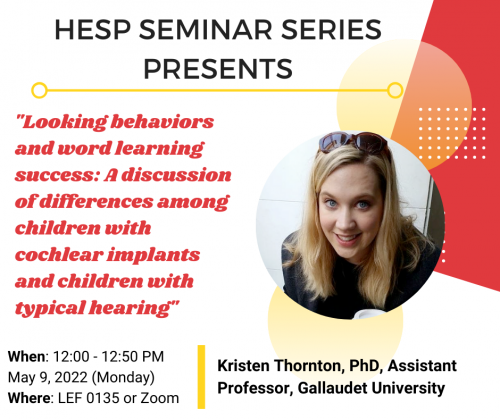Title: Looking behaviors and word learning success: A discussion of differences among children with cochlear implants and children with typical hearing
Abstract: Children with CIs are often included in mainstream classrooms; however, listening and learning in a classroom can be a considerable challenge for this group. Not only are children with CIs significantly impacted by background noise, but they must also make sense of a degraded and underspecified signal from their device(s) using an immature language system. To overcome difficult listening conditions, children with CIs may be instructed to utilize visual speech cues from the speaker. Although visual speech cues can augment word and sentence recognition, the role of audiovisual information in supporting more complex tasks, such as novel word learning, is not well understood. This preliminary study sought to fill this knowledge gap and was designed to address two primary aims: 1) Investigate the relationship between looking behaviors and novel word learning across CI and typical hearing groups, 2) Characterize individual differences in word learning success among children with CIs.
Children with CIs and with typical hearing completed two novel word learning tasks. During task presentations, eye tracking was used to measure looking behaviors to the narrator. For children with CIs, individual looking behaviors corresponded with word learning outcomes where word learning was positively correlated with time spent looking at the speaker’s mouth; however, for children with typical hearing, a negative correlation between learning success and looking time to the speaker’s mouth was observed. Learning strategies for vocabulary and their possible relationship to cognitive load will be discussed.
Please sign up for a time to meet with/greet her here. Additionally, we will be going to lunch after her talk at 1PM. Please let Meg Cychosz know if you would like to join —postdocs and graduate students are especially welcome!



